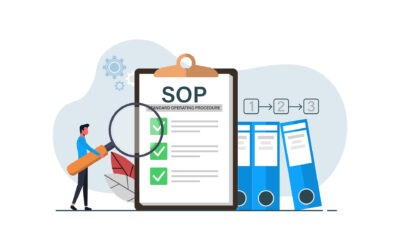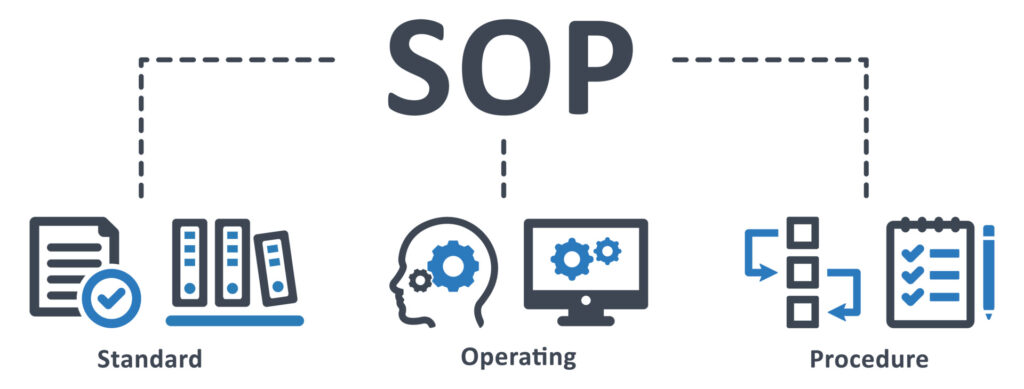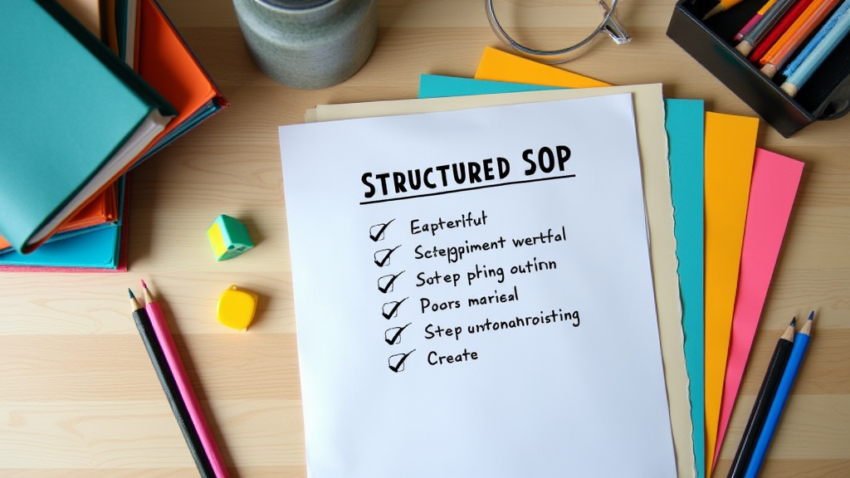Knowing how to write an SOP for operational efficiency is an important skill that helps teams and businesses become more consistent.
When you or a team member put together a strong SOP, make sure that everyone understands the reason for doing so, and know the exact steps needed to perform a task or process.
Having all this useful information only stored in your personal memory bank (or that of a supervisor) is a disaster waiting to happen if you fall ill, travel, or have a medical emergency.
It creates confusion, wastes time, and creates mistakes that can cost money or harm the work environment. A good SOP checklist in place, ensures that nothing important gets skipped!
Why Write an SOP?: Structure Matters for Operational Efficiency

SOPs give people a clear guide to get work done the right way every time. Well-written procedures improve teamwork, reduce errors, and help with training new staff.
SOPs also play a big role in meeting industry standards and passing audits. They cut costs on endless hours or re-work
For example, healthcare organizations rely on strict SOPs to guarantee patient safety, while manufacturing teams use procedures to produce quality products at scale.
Even small businesses use SOPs to make sure customers get the same service each visit.
Research shows that businesses with SOPs spend less time solving problems and more time growing.
According to the International Organization for Standardization (ISO), having formalized procedures can save hours per week per employee by eliminating repeat questions and clarifying responsibilities (ISO).
SOPs are not just for big companies. When you create even a simple checklist for a repetitive task, your workflow gets smoother and results become more reliable. With today’s digital tools, sharing and updating procedures is easier than ever.
Plus, SOPs help businesses respond faster to changes in the market and keep teams aligned with company goals.
Key Elements To Include in Every SOP
Getting the fundamentals in place makes the difference between a useful SOP and a confusing one. Follow a template that covers all the bases, whether you are writing a procedure for onboarding new staff or handling customer returns.
Necessary Must-Haves to Write an SOP
Here are the key elements to always include when you write an SOP:
- Title and Purpose Statement: Give each SOP a clear title and explain why it’s needed. This helps people see where it fits in the bigger picture.
- Scope: Define exactly what the procedure covers and what it does not. This keeps things focused and avoids overlap.
- Roles and Responsibilities: List who does what, so there’s no confusion about ownership.
- Definitions: If you use technical terms or acronyms, explain them to avoid misunderstanding especially by new team members.
- Step by Step Instructions: Break down each task into clear, numbered steps. If pictures or screenshots help, include them.
- Required Materials or Tools: Listing what’s needed upfront helps everyone show up prepared.
- Safety or Compliance Notes (if relevant): Call out any legal, safety, or regulatory requirements.
- Review and Approval: Document who signs off on the SOP and when it needs to be reviewed again.

Using these elements builds trust and clarity. By covering these basics, your SOPs will be much easier to follow, and onboarding becomes faster for new employees.
Creating SOPs with these core sections helps set the standard for quality and consistency, regardless of business size.
Step by Step How to Write an SOP: Your Checklist
Writing an SOP does not have to be complicated, nor is it rocket science – IF you know what to do. Use a checklist system so you don’t miss any important parts
- Identify the process or task: Decide what needs a formal procedure and why. Sometimes, start by making a list of recurring tasks that often result in confusion or mistakes as those are excellent candidates.
- Gather background information: Talk to the people who do the work, review any existing documentation, and collect any standards you must follow.
- Draft the purpose and scope: Write a short summary of what the SOP will cover and its limits. Clarifying the boundaries keeps the SOP focused and avoids unnecessary steps.
- List roles and responsibilities: Assign each part of the process to specific people or teams, making sure all parts of the workflow are covered.
- Create the step by step instructions: Write out each action in order, using simple language. Double-check the steps by walking through the process or having someone else try them out. It’s important to be precise, but not overly technical, so anyone can follow along.
- Add tools, materials, and safety requirements: Make sure people know what they need before starting the procedure. Include details like software, machinery, or protective equipment.
- Attach visuals if helpful: Diagrams, checklists, and flowcharts can clarify complex steps, breaking up text and adding visual cues for quicker understanding.
- Proofread and test: Have someone else review the draft and try following it. Adjust anything that is unclear or missing. Testing the procedure in real situations makes it stronger and ultimately more useful.
- Get approvals: Make sure managers or experts sign off, especially if legal or compliance rules are involved. Document this for future reference.
- Set a review schedule: Decide how often the SOP needs to be updated and who will do it. A good rule of thumb is to review after a significant incident, technology update, or organizational change.
This checklist approach guarantees that your SOPs are complete and ready to use from day one. It also helps when you need to quickly train someone new or explain a process to another team.
Common Challenges and How to Tackle Them
Some hurdles you will face when writing or updating SOPs come up repeatedly. These are a few I run into, along with how I address them:
- Too much jargon or vague steps: I keep my language simple and ask a team member to test the instructions, watching out for confusion. Jargon can slow people down or lead to costly errors. Getting fresh eyes on the SOP often reveals unclear spots.
- Process changes or drift: I schedule regular reviews and encourage feedback from team members, so SOPs stay accurate and relevant. I ask those closest to the daily work to flag any changes that could affect the procedure.
- Lack of buy-in from staff: I involve those who use the SOP in the drafting and testing phases, so they feel included and more likely to follow the new procedure. Sharing the reasons behind each step and how it helps makes it easier to get support from everyone involved.
- Poor organization or version control: I save all SOPs in a central location with clear version numbers and create a log of updates. This makes sure everyone is on the same page and using the correct version.
No SOP is perfect on the first try, but staying open to comments and keeping up with needed changes means the document keeps working for everyone.
When you make it a habit to update SOPs after incidents or feedback, it helps build a culture of continuous improvement.
Getting The Most From Your SOPs With Simple Tools

For starters, these days, you really don’t need fancy software to write clear SOPs.
Use what’s already available, like Google Docs for easy sharing and updates, or cloud storage for document access from anywhere.
For teams spread out in different locations, collaboration tools let everyone leave comments and suggest edits in real time.
Using a spreadsheet or a basic document tracker can help monitor each SOP’s status and history, making things much easier to manage as your organization grows.
If I want to track revisions, Microsoft Word or Google Docs have built-in version controls. For more detailed tracking, you might use a spreadsheet to log review dates and who approved each version.
These small steps keep everything transparent and easy to manage. Over time, the simple tools can support even complex operations as long as the documentation stays clear and up to date.
Real BCINC Examples of SOP Benefits
When we rolled out a streamlined new SOP for field crew onboarding at a small survey company, we noticed fewer mistakes and faster training times for new hires.
.Before that, each division had their “own way” of training new technicians, relying heavily on job-shadowing, leading to inconsistent results.
By agreeing on a step by step checklist, everyone started following the same process, which improved the experience and morale of technicians – eliminating frustrations.
In a small manufacturing company, introducing SOPs for equipment maintenance led to fewer breakdowns and longer machine life, while regular use of a materials checklist in construction ensured that nothing got missed, thereby reducing costly delays.
In a small office, having SOPs for invoicing and document storage helped the team find what they needed quickly, cutting down on wasted time and double work. SOPs really do create a more organized and predictable workflow, even when unexpected issues pop up.
- Improved training: New staff can get up to speed faster by following established procedures.
- Consistency: Customers and partners know what to expect every time.
- Audit readiness: Having SOPs in place make it easier to pass audits or inspections.
- Better problem solving: Clear procedures make it easier to spot and fix problems before they get bigger.
Adding SOPs can also help prevent business intellectual knowledge from being lost when team members leave and improve communication between departments. These benefits apply whether you run a small business, a nonprofit, or a large enterprise.
SOPs and Continuous Improvement
SOPs are more than just checklists. Each time you use them, look for ways to improve how you work. Encouraging suggestions from others helps keep the process flexible and responsive to real needs.
Revising SOPs based on real feedback saves frustration and makes the team stronger over time. By treating SOPs as living documents, you keep your operations organized, efficient, and ready for whatever comes next.
Making SOPs a regular part of your workflow lets you focus on growth and delivering consistently great results instead of scrambling to fix avoidable mistakes.
Conclusion – How to Write an SOP
Now that you better understand how to write an SOP, what is keeping you back? Sometimes time is the main culprit.
Need Help? Contact BCINC for Assistance Now!We will efficiently work with you to create winning SOPs for your business that will improve operational efficiency.
Related Articles
FAQs About How to Write an SOP
Below are a few questions that often come up when I talk with colleagues or clients about setting up new procedures:
How often should I review my SOPs?
Most SOPs benefit from at least an annual review. Some high-risk procedures may need to be checked every few months, especially if regulations or equipment change. Don’t forget to update SOPs after major incidents or technology upgrades, too.
Should I use visuals in my SOPs?
Yes. Photos, diagrams, and flowcharts make complicated steps much clearer, especially for people who learn better visually. Even a simple drawing or a screenshot can give a big boost to comprehension and reduce mistakes.
Where should I keep my SOPs?
Keep them in a shared drive or document management system so everyone can access them. Cloud storage also allows for easy version control and remote access. Having SOPs available online makes updates easier and gives everyone the latest copy, which helps avoid confusion.

